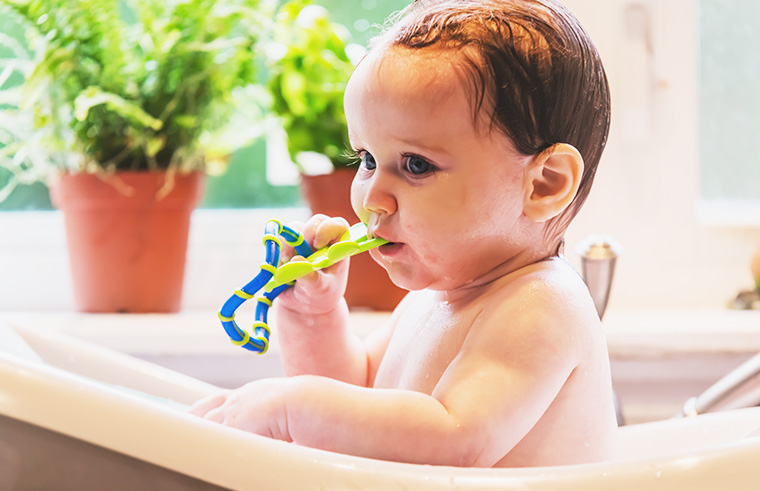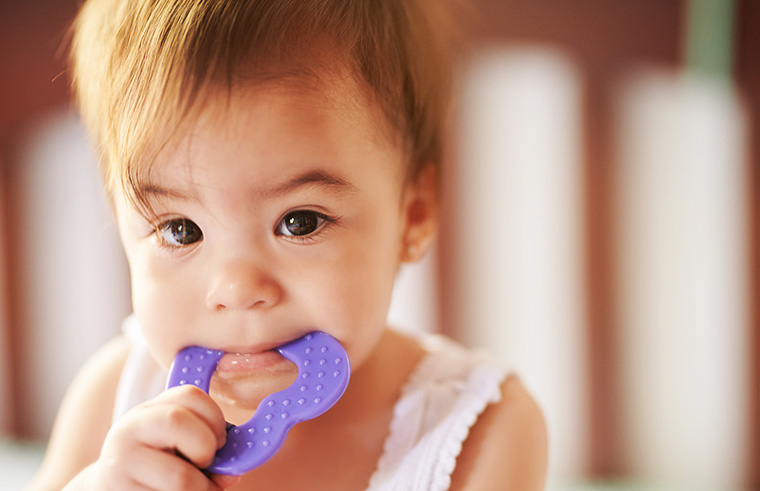Babies’ “teething pain” being treated the wrong way, putting them at risk

If you imagine a teething child, what do you see? An irritable tot with a fever, in pain, and generally unwell?
Teething’s a normal developmental process that people have long associated with illness. However, the evidence says otherwise.
How strong is this evidence? Is there anything you can do to help a teething child? What about teething gels and teething necklaces?
Teething is when new teeth emerge through the gums, and usually starts at about six months of age.
A review of 16 studies found that although teething was linked with signs and symptoms, these were usually mild involving gum irritation, irritability, and drooling.
Although body temperature may be slightly raised, the review found poor evidence to suggest teething caused fever. Many symptoms linked to teething, like irritability, sleep disturbance and drooling, are difficult to measure objectively and are based on what parents report, which is subjective and may be inaccurate.
And, as teething comes and goes, and its timing is relatively unpredictable, recording even measurable symptoms like temperature changes in a reproducible, reliable way is virtually impossible.
So teething problems seem to be over-reported in the types of studies that rely on people remembering what happened.
What else could cause the symptoms?
Other biological triggers may in fact explain the symptoms traditionally linked to teething. Teething coincides with normal changes in children’s immunity; the mother’s antibodies are transferred to babies in pregnancy and help protect the baby in the first 6-12 months of life, but start to wane at about the same time as teething.
This, together with behavioural changes as infants start to explore their surroundings, increases the chances of catching viral infections with symptoms like those reported for teething.
Separation anxiety and normal changes in sleep patterns may also account for irritability and sleep disturbances, which may be mistakenly attributed to teething.
As teething symptoms are generally likely to be mild and focused on the mouth, parents are warned against presuming that signs of illness in other parts of the body are due to teething. That’s because this may delay the detection of potentially serious infections that may need medical attention. It may also delay parents getting help settling their child to sleep.
How about teething gels?
The search for solutions to the perceived problem of teething may lead parents to pin their hopes on gels, toys and other products, none of which have been scientifically assessed to alleviate teething symptoms.
Nevertheless, teething gels usually contain a variety of ingredients that help relieve supposed teething-related symptoms. Some, such as the recently discontinued Adelaide Women’s and Children’s Hospital Teething Gel, contain the anaesthetic lidocaine.
Very little lidocaine is absorbed into the body when applied to the gums, and only minor complications like vomiting have been reported in Australia. However, accidental swallowing and applying too much can lead to poisoning, resulting in seizures, brain injury, and heart problems.

The decision to discontinue the gel follows a 2014 warning issued by the US Food and Drug Administration against using teething gels with topical anaesthetics, after reports of infant and child hospitalisation and death.
There have also been warnings about teething gels containing benzocaine. This is another anaesthetic applied to the gums that can lead to a dangerous and fatal blood condition called methaemoglobinaemia, which affects the blood’s ability to carry oxygen.
Another common ingredient in popular teething gels is choline salicylate, an anti-inflammatory similar to aspirin. This increases the risk of liver disease and brain injury if the child eats too much. This may also carry the risk of Reye syndrome, a rare but serious condition that can lead to seizures, loss of consciousness and death. Reye syndrome has been linked to the use of aspirin in children, particularly during viral infections.
A case of suspected teething gel-induced Reye syndrome in 2008 led to the products being contraindicated (warned against) in children in the UK.
A number of young Australian children who used too much salicylate-containing teething gel have also reportedly been hospitalised with side-effects. But the products are still available in Australia.

How about ‘natural’ products?
Although a range of “natural” and homeopathic teething solutions are heavily marketed to parents of young children, these too have risks.
A manufacturer recently recalled a range of natural teething gels after cases of reported poisoning. And US regulatory authorities found the same range contained higher than reported levels of belladonna, a poisonous plant that despite its dangers is used as a homeopathic pain killer and sedative.
In searching for “natural” therapies, parents are also turning to amber teething necklaces that supposedly relieve teething symptoms. Amber is a fossilised tree resin that has historically been suggested to have anti-inflammatory properties.


However, several widely reported cases of strangulation have led to warnings from both US and Australian regulatory authorities. There is currently no scientific evidence these necklaces work.
The Australian Competition and Consumer Commission (ACCC) says amber and other “teething” necklaces, even when mothers wear them, are: … colourful and playful in design, and may be confused with toys.
All toys for children aged 36 months and below, including teething toys, are strictly regulated by Australian standards. As the ACCC warns, teething necklaces are unlikely to fulfil this requirement.
What to do?
So what are the best options to relieve teething symptoms? With a lack of any good-quality evidence to recommend any specific therapy, experts suggest the best remedy is affection and attention.
Rubbing a clean finger on the gum, or applying gentle, firm pressure with a cooled (but not frozen), clean washcloth or teething ring may provide some relief. Although it’s hard to know exactly how these work, they are unlikely to lead to serious problems.
Teething can be a difficult time, but it will eventually pass. In the meantime, it is important that parents avoid falling prey to supposed cures that are not only unproven, but are also potentially dangerous.
Mihiri Silva, Paediatric dentist, Senior Lecturer and Post-doctoral Research Fellow, Murdoch Children’s Research Institute
This article is republished from The Conversation under a Creative Commons license. Read the original article.








